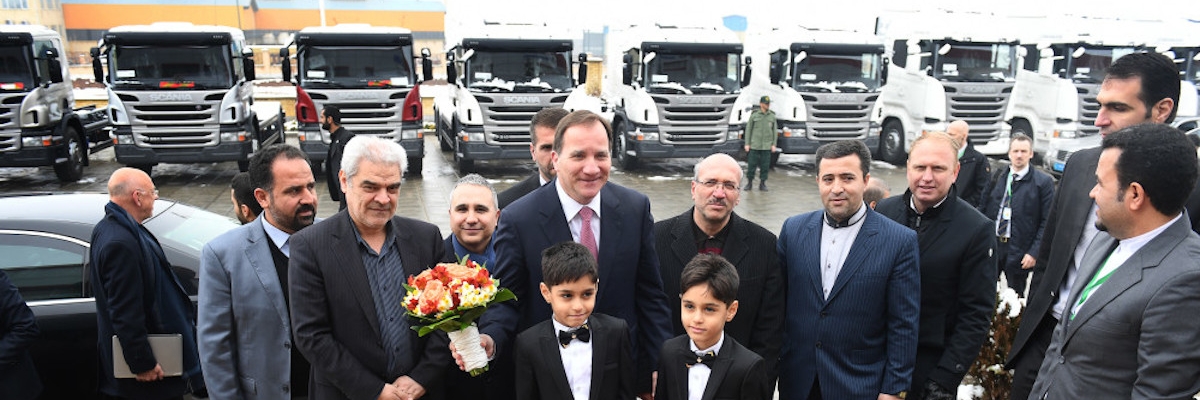Swedish Prime Minister Visits Scania in Iran, A Case Study in Commitment
On Sunday, Swedish Prime Minister Stefan Löfven visited the Scania truck factory in Qazvin, 25 miles west of Tehran.
The visit, which was a key stop in the itinerary of the largest Swedish business delegation to ever visit Iran, served as an important milestone for Swedish commercial vehicle company Scania, which has demonstrated remarkable perseverance in the Iranian market over the last two decades. Löfven was able to take a tour of the assembly line and meet with workers at the Qazvin facility, who produce nearly 1000 trucks a year emblazoned with Scania’s famous red griffin badge.
Scania did not mothball its operations in Iran during the sanctions period, choosing instead to continue manufacturing both trucks and buses while competitors such as Volvo, Renault, and Daimler pulled out of the country. Scania's perseverance required extensive coordination with parent company VAG and European regulators. According to Scania CEO Henrik Henriksson, Scania was able to continue its activities in Iran with the necessary approvals only by “maintaining open books with all relevant authorities.”
While Scania’s global competitors are now moving back into the market (Volvo Trucks, another Swedish firm, was also a member of the delegation), the company enjoys a leading position in both the truck and bus market segments in Iran, controlling 64% and 37% of the respective marketshare.
For Henriksson, these figures are a point of pride. “We stood by our customers,” he declared in an interview with Swedish publication TT. Scania’s CEO has visited Iran seven times in the last year—more than any other country—as the company seeks to expand its local production.
The Swedish company works with two local partners. Mammut Diesel, part of the wider Mammut Industrial Group, has been a partner since 2008 and produced 991 Scania trucks at the Qazvin facility last year. Oghab Afshan, which has been a local partner since 2000, produced 863 Scania buses at its facility outside Esfahan last year. The local parts content of Scania vehicles manufactured in Iran is an impressive 20%, but the company is seeking to increase that proportion to 30% by 2018.
Currently, the annual export value for Sweden represented by Scania’s business in Iran is USD 336 million, but Henriksson believes this figure could double if financial channels to Iran were opened. "It is no secret that it is difficult to do business. Channels must be opened if the market is really to take off," he noted.
In coordination with the Prime Minister’s visit, Scania announced a new contract to supply 1350 buses to Esfahan and four other Iranian cities. The first deliveries are expected by the end of this year. The financing for 1000 of these buses will be made available by Shahr-e Atiyeh, an Iranian investment company.
Scania’s success in Iran can be seen as a case study in commitment. Major multinationals that were able to remain active in the Iranian market during sanctions, in part due to the measured support of their governments back home, now find themselves in market-leading positions as competitors try to catch-up.
But beyond the sheer commercial and operational dominance, the Scania success story is also reflective of a strong cultural and ethical approach typical of Swedish industry. Swedish companies have grown accustomed to high public expectations—Swedish media has called attention to salary levels at Scania's Iranian partner firms— but the application of any true corporate ethics in Iran remains a low priority among many multinational firms in Iran. Scania stands out for having generated significant goodwill with its local partners and Iranian policymakers due to its commitment to knowledge and technology transfer.
Scania has made significant efforts to bring the green technologies available in the European commercial vehicle market to Iran. Mammut recently signed a trilateral cooperation agreement with Iran’s Road Maintenance and Transportation Organization and the Iranian Fuel Conservation Company to support the replacement of 5,000 aging trucks with Scania models that boast better fuel efficiency and lower emissions.
Speaking in advance of the Prime Minister’s visit, Henriksson stated that the firm is seeking to expand its constructive role. "We can contribute with our skills in leadership and education. We want to take part in the effort to improve the environment and road safety in Iran, and hope to receive the support of the Swedish government for this," he said.
As commercial rewards flow from this value-driven business strategy, Scania can serve as a model to other industrial multinationals and their Iranian local partners.
Photo Credit: Urban Andersson




